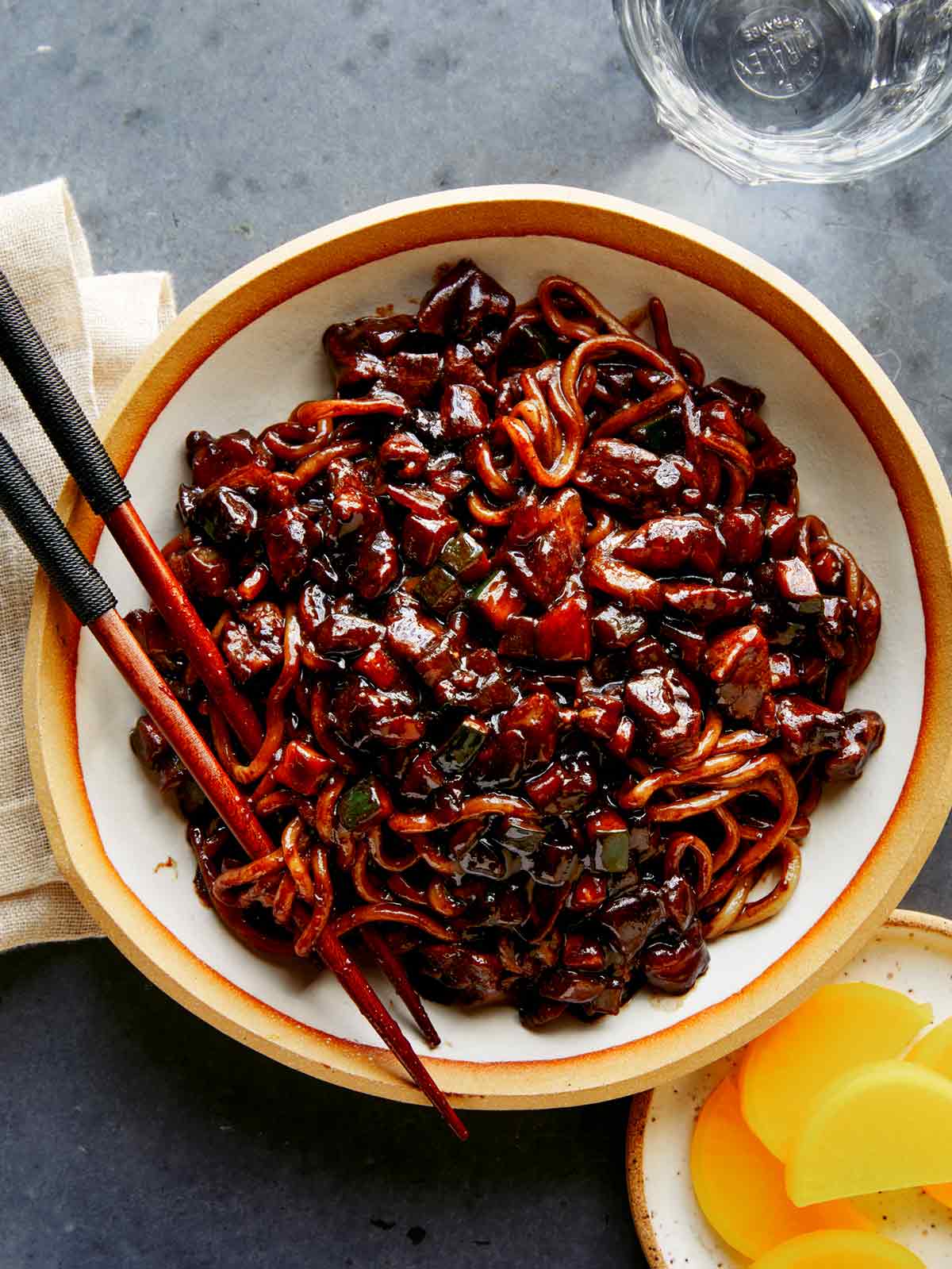
I’m extra excited about our recipe for Jajangmyeon (noodles in black bean sauce)! It’s one of my absolute favorite childhood dishes. Our jajangmyeon recipe is inspired by my dad’s version I had growing up; it has always been one of my favorite dishes of his to eat!
The silky, savory black bean sauce has the most addicting umami flavor. It’s a dish that’s really unlike any other and it’s part of a lesser known asian hybrid cuisine.
What is Jajangmyeon?
Jajangmyeon is a casual, comfort noodle dish that is smothered in a savory black bean sauce. It’s part of a Korean Chinese hybrid cuisine, which is a lesser known cuisine developed in the 19th century by early Chinese immigrants in Korea. Korean Chinese food is a huge and popular part of Korean food culture. Jajangmyeon is among one of the most popular Korean Chinese dishes along with Jjamppong (a spicy seafood noodle soup) and Tangsuyuk (a sweet and sour dish often made with chicken, pork or beef).
The noodles used are fresh udon noodles, which are thick wheat based noodles. The base of the sauce is made from Korean black bean paste (called chunjang) which is made from soybeans, flour, caramel and fermented. Ingredients like onion, zucchini and pork are sautéed and mixed with the paste along with a cornstarch slurry and water to create a gravy-like consistency that coats the noodles.
How to Make Jajangmyeon
Important Ingredients to Note
- chunjang – is a Korean style black bean paste. It’s made of soybeans, wheat flour and caramel and fermented. It can be found at Korean (and some Chinese) grocery stores. Chinese style black bean paste is not a suitable substitute and shouldn’t be used in its place. Chunjang needs to be toasted first to remove the sour and bitter flavor, but you can often find pre-toasted chunjang at Korean grocery stores, you just need to make sure to check the labels.
- udon/jajangmyeon noodles – are thick wheat noodles (usually fresh or frozen) and are the best option for jajangmyeon. They can be found in most asian grocery stores in the refrigerated or frozen food sections. They are most often found labeled as udon noodles or jajangmyeon noodles.
- danmuji – is yellow pickled radish and is often served as a condiment or side dish (banchan) to a variety of snack type foods as well as different Korean Chinese dishes. It has a sweet and sour flavor and crisp texture that pairs well with the salty and savory jajangmyeon sauce.
Process
PORK MARINADE

- Combine pork shoulder, mirin, ginger, salt, and pepper and stir together. Set aside.
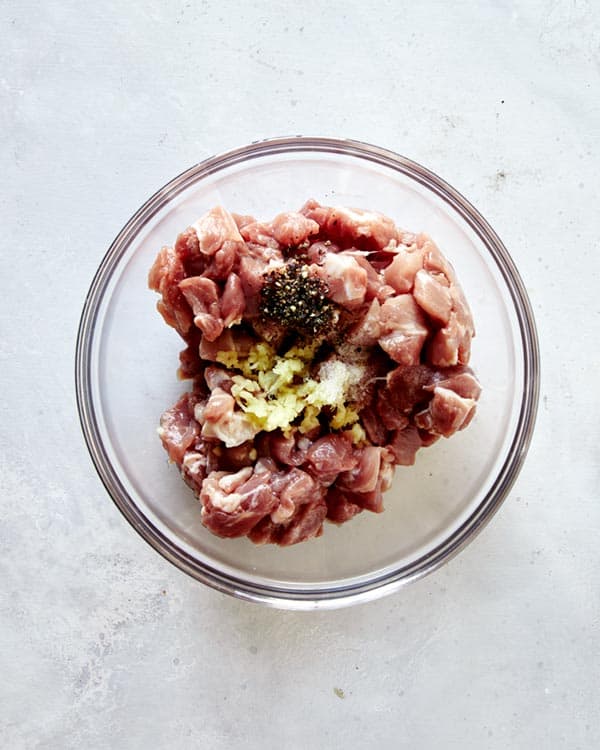

TOASTED JAJANG

- Place a large skillet over low heat and add oil.
- Once oil is hot, add black bean paste and sugar and stir together. Continuously stir for a few minutes to toast.
- Pour mixture into a small bowl and set aside.


TO ASSEMBLE
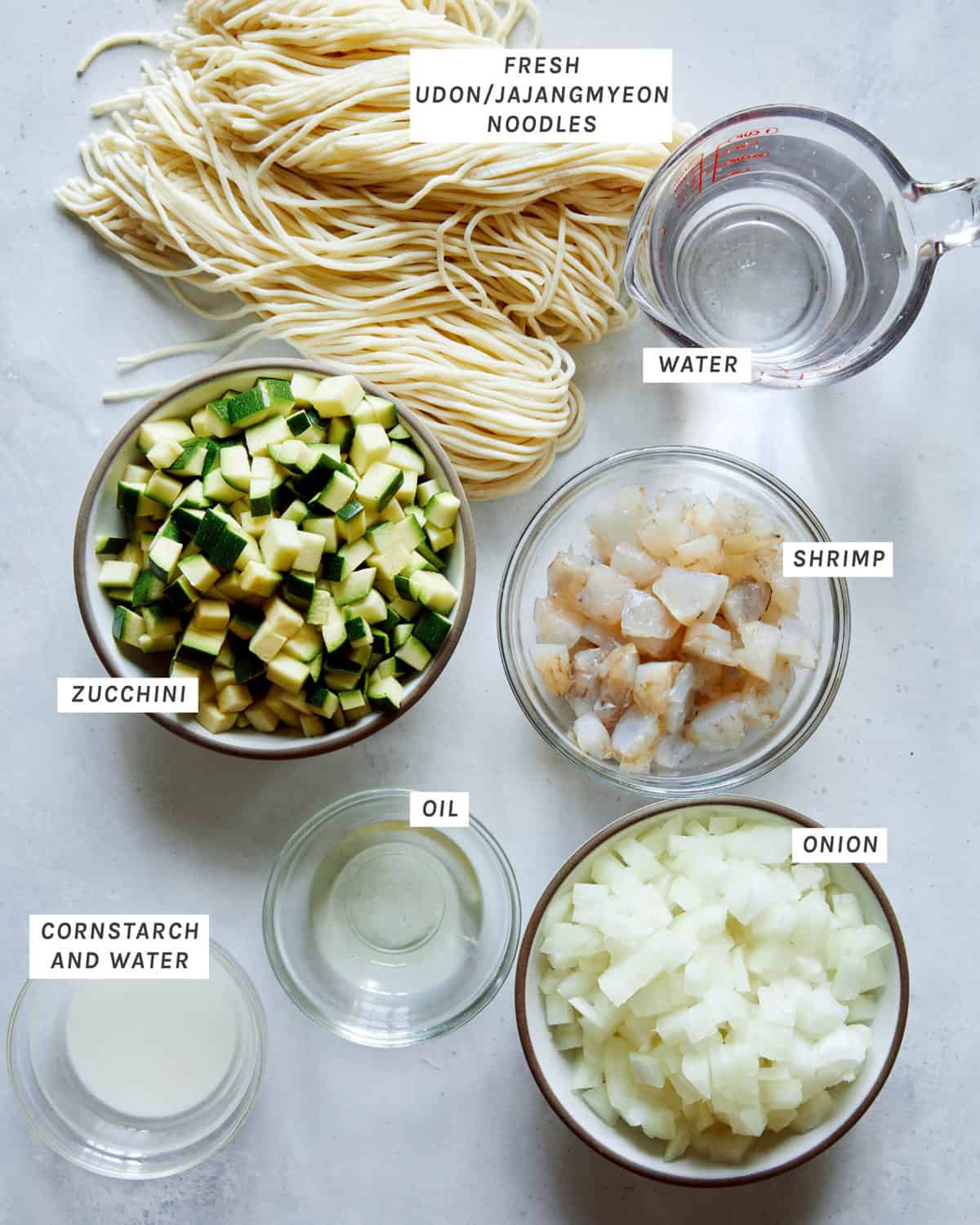
- Place skillet back over medium heat. Add oil and sauté marinated pork for a few minutes.
- Add shrimp and continue to sauté.


- Transfer pork and shrimp mixture to a plate and set aside.
- Place skillet back over medium-high heat. Add remaining oil and sauté onion, 3 to 4 minutes.
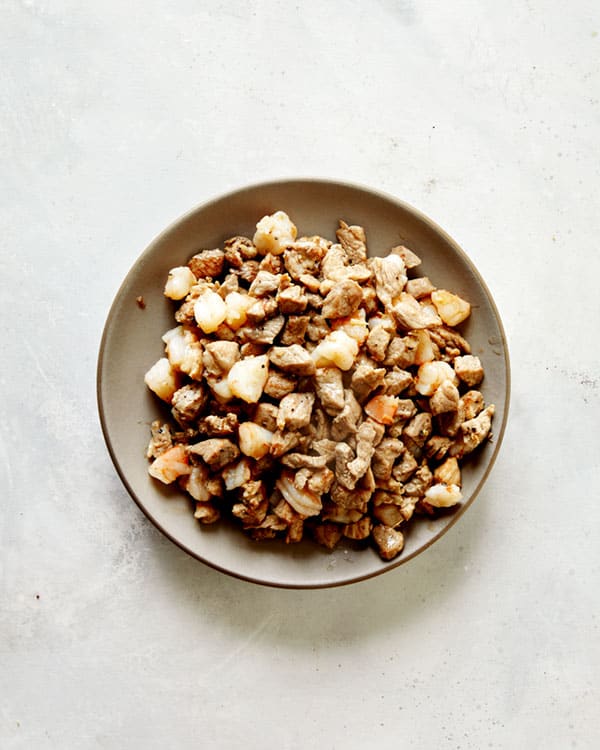

- Add zucchini and continue to sauté for an additional 2 to 3 minutes.
- Pour pork and shrimp mixture back into the skillet and continue to sauté for 2 to 3 minutes.


- Stir toasted black bean paste into meat and vegetable mixture until evenly coated.
- Stir water into skillet mixture until sauce is smooth and simmering.
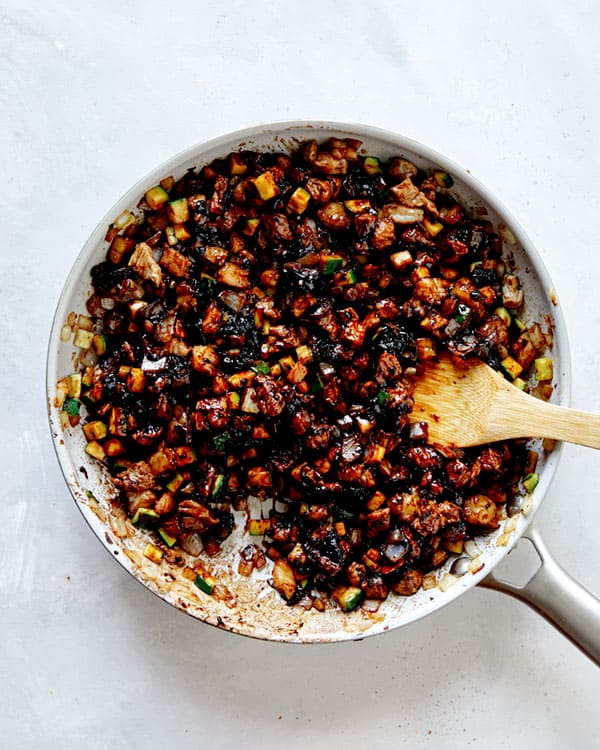
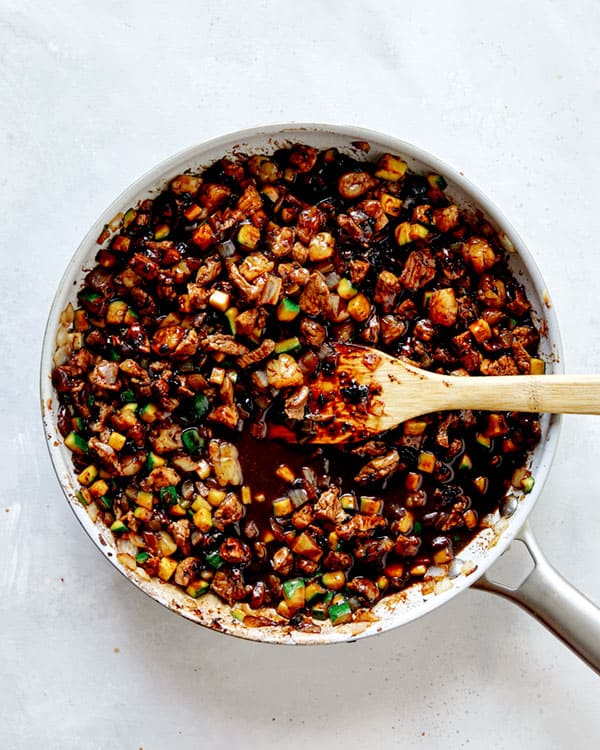
- Add cornstarch slurry and stir together until sauce thickens. Remove from heat and keep warm.
- Fill a large pot with water and place over high heat. When water begins to boil, add noodles and cook through, stirring occasionally, until noodles are cooked through, but still a little chewy, about 5 to 6 minutes. Drain noodles into a colander and give them a gentle and quick rinse.

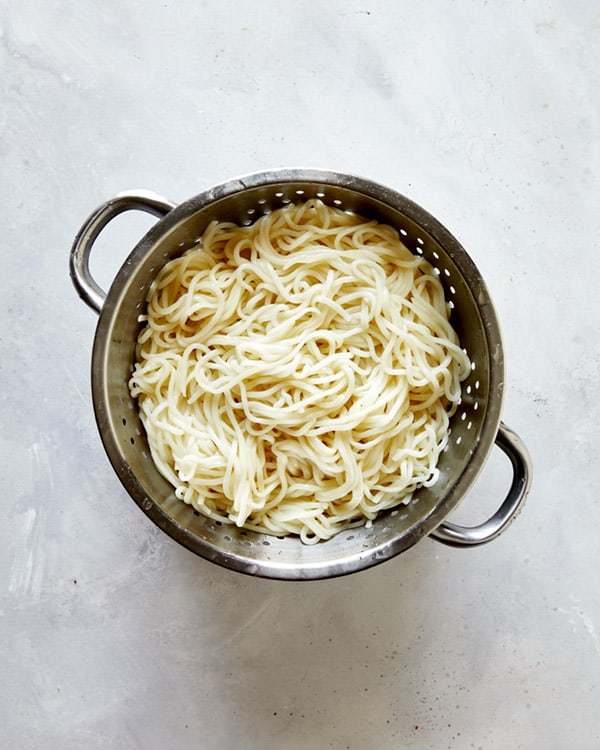
- Divide noodles into bowls and top each with ladles of sauce.
- Mix noodle and sauce together.


Tools You Will Need
- cutting board
- knife
- mixing bowls
- liquid measuring cup
- dry measuring cups
- measuring spoons
- wooden spoons
- large pot
- colander
- large sauté pan
Tips and Tricks for Jajangmyeon Success
- Toast the chunjang over low to medium-low heat to prevent it from burning. Some dried bits may stick to the bottom of the pan, which is okay as you’ll be able to scrape it up as you make the rest of the sauce.
Different Types of Jajangmyeon
- a “dry” version (ganjjajangmyeon) – water and the cornstarch slurry is omitted here, making it less of a sauce and more of a meat and vegetable mixture that is coated in black bean paste.
- a mixed seafood version (samseon jjajangmyeon) – a popular version of the dish that usually omits the pork and uses a variety of seafoods instead, such as shrimp, squid and sea cucumbers.
- stir fried (jaengban jjajang) – the sauce and noodles are tossed together and stir fried together in this version and usually served on a large platter, family-style.
- over rice instead of noodles (jjajangbap) – another popular way to eat this dish is to serve it over rice instead of noodles. The dry sauce version from above is also often used in jjajangbap.
Sauce Variations
Jajangmyeon sauce is made a number of ways depending on preference. Some of the most common and popular variations include:
- Garnishing with julienne cucumber is one of the most popular ways to serve jajangmyeon. The cool, mild flavor and crisp texture pair well with the savory, salty dish.
- Gochugaru (Korean chile pepper) can be stirred into the sauce if you want to add some heat to the sauce.
- Make it vegetarian with tofu or mushrooms (or both) and just omit the pork and shrimp.
- Other popular and commonly used vegetables in jajangmyeon are diced potatoes, diced carrots, peas, chopped green cabbage, and corn.
- Diced pork belly is commonly used in jajangmyeon, but I prefer the texture of pork shoulder in this dish. Either work great!
Other Noodle Recipes You Will Love
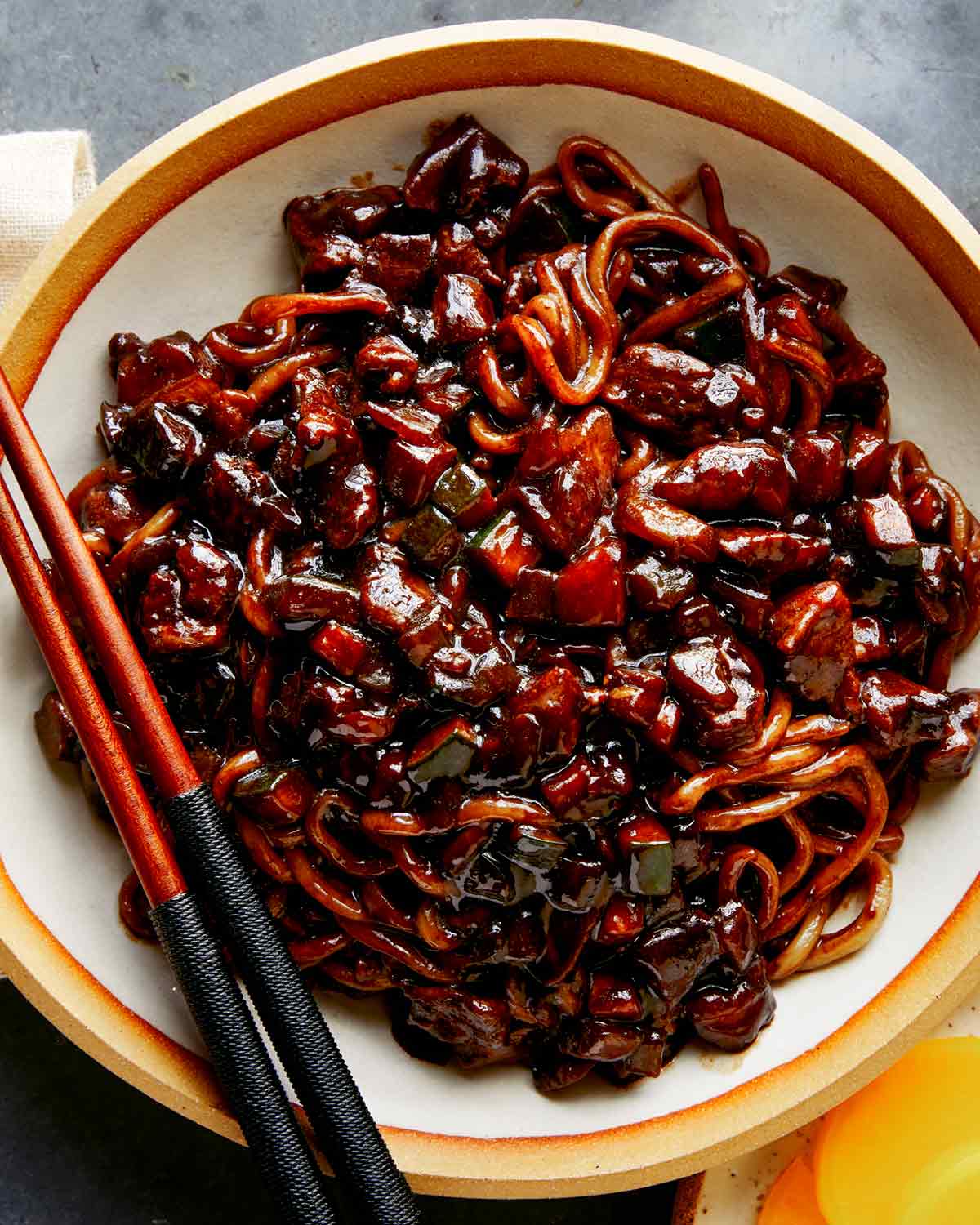
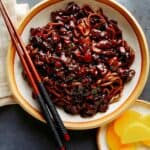
Jajangmyeon (Noodles with Black Bean Sauce)
INGREDIENTS
pork marinade
- 3/4 pound diced (boneless) pork shoulder
- 1 tablespoon mirin
- 1 teaspoon minced ginger
- 1/2 teaspoon salt
- 1/8 teaspoon black pepper
toasted jajang
- 2 tablespoons neutral oil
- 1/2 cup chunjang (Korean black bean paste)
- 1 tablespoon sugar
rest of the dish
- 2 tablespoons neutral oil
- 1/4 pound peeled, deveined and chopped large shrimp (about 6)
- 1 diced yellow onion
- 2 diced zucchini
- 1 cup water
- 1 1/2 tablespoons cornstarch (combined with 3 tablespoons water)
- 24 ounces fresh udon/jajangmyeon noodles
INSTRUCTIONS
pork marinade
- Combine pork shoulder, mirin, ginger, salt, and pepper and stir together. Set aside.
toasted jajang
- Place a large skillet over low heat and add oil. Once oil is hot, add black bean paste and sugar and stir together. Continuously stir for 3 to 4 minutes to toast.
- Pour mixture into a small bowl and set aside.
assembly
- Place skillet back over medium heat. Add 1 tablespoon oil and sauté marinated pork for 3 to 4 minutes.
- Add shrimp and continue to sauté for 2 minutes.
- Transfer pork and shrimp mixture to a plate and set aside.
- Place skillet back over medium-high heat. Add remaining oil and sauté onion, 3 to 4minutes.
- Add zucchini and continue to sauté for an additional 2 to 3 minutes.
- Pour pork and shrimp mixture back into the skillet and continue to sauté for 2 to 3 minutes.
- Stir toasted black bean paste into meat and vegetable mixture until evenly coated.
- Stir water into skillet mixture until sauce is smooth and simmering.
- Add cornstarch slurry and stir together until sauce thickens. Remove from heat and keep warm.
- Fill a large pot with water and place over high heat. When water begins to boil, add noodles and cook through, stirring occasionally, until noodles are cooked through, but still a little chewy, about 5 to 6 minutes. Drain noodles into a colander and give them a gentle and quick rinse.
- Divide noodles into bowls and top each with ladles of sauce. Mix together.
NOTES
- Toast the chunjang over low to medium-low heat to prevent it from burning. Some dried bits may stick to the bottom of the pan, which is okay as you’ll be able to scrape it up as you make the rest of the sauce.
- Garnishing with julienne cucumber is one of the most popular ways to serve jajangmyeon. The cool, mild flavor and crisp texture pair well with the savory, salty dish.
- Gochugaru (Korean chile pepper) can be stirred into the sauce if you want to add some heat to the sauce.
- Make it vegetarian with tofu or mushrooms (or both) and just omit the pork and shrimp.
- Other popular and commonly used vegetables in jajangmyeon are diced potatoes, diced carrots, peas, chopped green cabbage, and corn.
- Diced pork belly is commonly used in jajangmyeon, but I prefer the texture of pork shoulder in this dish. Either work great!








Did you make this recipe? We want to see!
tag @SpoonForkBacon and #SpoonForkBacon on Instagram
I bought the roasted chunjang sauce. Does that mean I can skip toasting?
During my stay in South Korea, I ordered some food in a local Korean restaurant that I had no idea what it was. A quick Google search pointed me here. It was so delicious and I am glad there is a recipe out there that I am make when I get back home.
Wow! Jajangmyeon is my favorite noodle dish and I always thought it was too complicated to make at home. This recipe was so easy and soooo tasty! It’s definitely going in family’s regular rotation. Thanks!
Hello! This is a great recipe! I burned the sauce while toasting. The tip said to use low heat, but I followed the instruction that said medium. Maybe the step could be updated? Thanks again, really enjoyed it
So happy you enjoyed this! Ah, yes it should definitely say toasted on low (or medium-low)! I will update that now. Thanks for letting me know!
This looks good, and I’d like to make it, but I live in a town that doesn’t have any Korean grocery stores. Can I find the ingredients at a supermarket?
Hi! The only ingredient you may not be able to find is the chunjang (Korean black bean paste), which you can find on amazon!
Delicious and so easy to make!
I can’t wait to make this!
Luckily, I’ve got a Korean grocery store nearby. 😋
Also, I’m looking for a new sauté pan. What pan do you use?